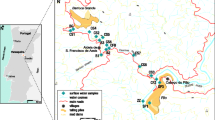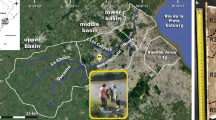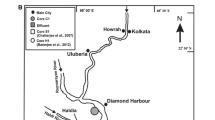Abstract
The Pimpama River floodplain has developed over the last several thousand years as a result of sea-level fluctuations that shaped the lower catchment and enabled the formation of sedimentary pyrite. The subsequent production of sulfuric acid due to the oxidation of this pyrite enhances the breakdown of metal-bearing sediments and can lead to leaching of major and trace metals into the waters of the region. The seasonal pattern of rainfall and current land-use activities are important aspects that intensify the natural production of acid and influence the release and distribution of metals. To identify the source and migration of metals in the Pimpama catchment and to understand the impact of pyrite oxidation on the distribution of metals in sediments and waters, several components of the drainage system were analyzed: bedrock, sediments from river bed and bank, and water. The elements analyzed in this study (V, Cr, Co, Ni, Cu, Zn and Pb) are all present in the bedrock material which explains their occurrence in the unconsolidated sediments of the floodplain. These metals concentrate in the upper section of the sedimentary sequence and their presence is related to clay minerals such as smectite, organic matter and iron phases. However, Zn, Mo and Co occur in higher amounts than the local background and within standard shale. This comparison suggests that the diagenetic processes alone cannot explain the higher concentrations and it is concluded that these metals also have an anthropogenic source. The formation of sulfuric acid creates conditions for higher mobility of some metals, such as Cr, Co, Ni, Cu, Zn, but does not affect less mobile ones such as Mo and Pb. Over the longterm, the production of acid influences the breakdown of mineral phases and enhances the process of weathering. Over the short term, every rain event leaches acid from sediments and mobilizes metals resulting in a substantial reduction in the quality of river water.
Similar content being viewed by others
Author information
Authors and Affiliations
Additional information
Received: 2 October 1998 · Accepted: 16 February 1999
Rights and permissions
About this article
Cite this article
Preda, M., Cox, M. Trace metals in acid sediments and waters, Pimpama catchment, southeast Queensland, Australia. Environmental Geology 40, 755–768 (2001). https://doi.org/10.1007/s002540100318
Issue Date:
DOI: https://doi.org/10.1007/s002540100318




